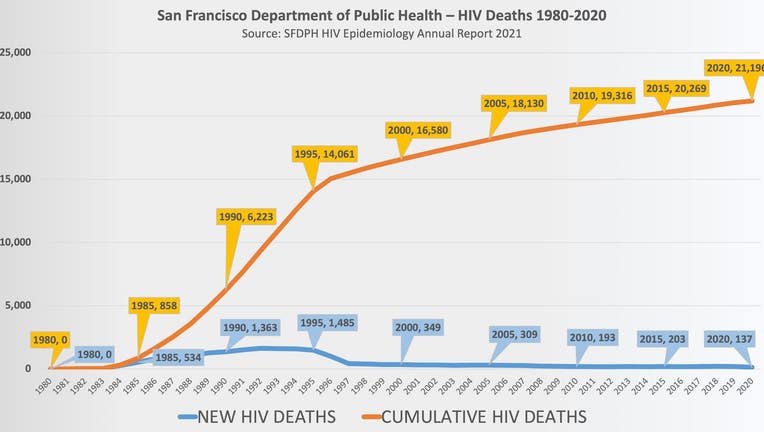On World AIDS Day, San Francisco has much to be proud of, but much work still left to do

Image courtesy SFDPH via BCN
SAN FRANCISCO - Nations across the globe commemorated World AIDS Day on Thursday, marking just over 40 years of struggles and triumphs surrounding the virus that has claimed over 40 million lives. In San Francisco, AIDS has taken the lives of over 21,196 people since it emerged in the early 1980s.
Though San Franciscans have much to be thankful for in the wake of new preventions and treatments for HIV infection, HIV continues to be a challenge in San Francisco, according to the San Francisco Department of Public Health.
As of 2021, there were 15,631 San Francisco residents diagnosed and living with HIV. Eleven percent of Californians who are living with HIV reside in San Francisco, though less than two percent of people living in the United States with HIV resided in the city.
"While the new infection rate is down 90 percent from its zenith, we still have new infections," said SFDPH Director of HIV Health Services Bill Blum. "While for those with access and resources to maintain regular healthcare HIV has become a chronic illness that can be managed, there are still many with personal and structural challenges that prevent them from getting and staying in care."
The less stable an HIV positive person's housing, for example, the more likely they are to have an active virus that is not controlled by medication, Blum said. There are also disparities in health outcomes in the Black/African American community, though these disparities have "decreased significantly," he said.
Another virus -- COVID-19 -- may also have had an effect on San Francisco's HIV numbers. In 2021, 160 new diagnoses were reported at an increase of 16 percent from the previous year, according to a report published by SFDPH in 2021. However, researchers are unclear if the increase is due to more people becoming infected or if diagnoses simply increased due to some people delaying testing during 2020 due to the pandemic.
For people experiencing homelessness, the report found that the proportion of new diagnoses among people experiencing homelessness has increased in the last decade, accounting for a high 24 percent of diagnoses in San Francisco in 2021-- that's one out of every four diagnoses.
Researchers and medical professionals look to what they call "care indicators" when they examine overall trends-- measuring a person's linkage to care (whether they moved into medical care after diagnosis), their retention in care (are they sustaining their medical care?), and viral suppression therapies.
In San Francisco, all three care indicators were lower in 2021 among Black/African Americans, people who inject drugs and people experiencing homelessness.
Blum said he's hopeful that new therapies that could make it easier for people with unstable housing or other challenges affecting their retention of care to manage their HIV and remain on a sustained treatment plan. The treatment is called "long-term injectables," which are intramuscular shot medications that last for two months.
MORE: 'Light in the Grove' on the eve of World AIDS Day
"And there's hope on the horizon that this will go to every six months to a year," he said.
San Francisco was unfortunately at the forefront of the epidemic but has also been at the forefront of doing something about it.
"San Francisco has been a leader in responding to the AIDS Crisis and has garnered international attention and respect," said Blum. "Given that we were one of the early epicenters of the epidemic in the U.S. and as there is world-class research and medical care as well as a large network of service organizations, SF has developed perhaps the most comprehensive and inclusive system of HIV care which many other jurisdictions have sought to emulate."
According to the SFDPH report, San Franciscans have an incredibly high awareness of their HIV status--97 percent-- compared to California overall at 88 percent and the U.S. at 87 percent. Use of pre-exposure prophylaxis is also very high in SF, at 75 percent, compared to the state's 26 percent and the U.S.'s 25 percent. Late-diagnosis of HIV is also lower in SF than in the state and the country, at 17 percent compared to California's 21 percent and the country's 22 percent.
However, people are still dying of AIDS in San Francisco. The 2020 death rate per 1,000 people with HIV was 17.5, higher than the state's number of 13.1 and about the same as the country's 17 percent.
Still, there is much to be thankful for.
"People are living with HIV and can lead happy, healthful lives," said Blum. "If you get tested and find out you are positive and get treated, you can live close to a very normal lifespan."

